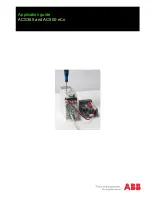
05-6358A01, Rev. 02 (FCC)
MDS SD1 Quick Start Guide (x710 Mode)
3
• An efficient and properly aligned antenna system providing
adequate received signal strength.
• Proper programming of the transceiver’s parameters
• The correct interface between the transceiver and the con-
nected data equipment (correct cable wiring, proper data
format, timing, etc.)
3.1
LEDs
The radio’s LED indicator panel provides useful information when
troubleshooting a system problem. Refer to
Table 1
for LED infor-
mation.
3.2
Event Codes
When an alarm condition exists, the transceiver creates a mes-
sage that can be read on a connected PC by using the
ALARM
command. Consult the
Reference Manual
for details.
3.2.1
Types of Alarms
Minor Alarms—
report conditions that, under most circumstances
will not prevent transceiver operation. This includes out-of-toler-
ance conditions, baud rate mismatches, etc. The cause of these
alarms should be investigated and corrected to prevent system
failure.
Major Alarms
—report serious conditions that generally indicate a
hardware failure, or other abnormal condition that will prevent (or
seriously hamper) further operation of the transceiver. Major
alarms may require factory repair. Contact your factory represen-
tative for assistance.
3.3
Built-In Spectrum Analyzer
A Spectrum Analyzer screen is available for viewing other radio
signals near the SD’s operating frequencies. Access to the ana-
lyzer is made with the
Spectrum
command.
Optionally, you can specify a frequency at the prompt to view the
surrounding spectrum of that frequency To do this, enter
Spec-
trum xxx.xx
, where
xxx.xx
is the frequency in MHz.
The display creates a received signal strength indication (RSSI)
vs. frequency plot for the frequency and surrounding signals. Refer
to the Reference Manual for more information.
4.1
COM1 Connections for PC Control
The COM1 DB-9 connector is used for PC management of the
radio. A straight-through cable is required that connects Pin 2
(RXD), Pin 3 (TXD), and Pin 5 (Ground). (See
Figure 7
.)
Figure 7. COM1 Wiring to Computer
4.2
COM2 Connections
The COM2
connector (
Figure 8
) is typically used to connect an
external DTE telemetry device to the radio, supporting the RS-232
or RS-485 (balanced) format, depending on how the radio is con-
figured. The radio supports data rates of 300, 1200, 2400, 4800,
9600, 19200, 38400, 57600, and 115200 bps (asynchronous data
only).
The COM2 connector mates with a standard DB-9 plug available
from many electronics parts distributors.
4.2.1
Pin Descriptions—RS-232 Mode
Table 2
provides pin descriptions for the connector when operating
in RS-232 mode. For RS-422/485, refer to the
Reference Manual
.
NOTE:
The radio is hard-wired as a DCE device.
Table 3
on the following page lists key software commands for the
SD transceiver. Many commands can be used in two ways:
1. The basic command (shown first) may be entered alone to
issue a query or execute a simple command.
2. The basic command may be appended with additional argu-
ments (shown in brackets, if applicable) to further define a set-
ting.
A complete list of commands and detailed descriptions is provided
in the SD
Reference Manual
(under development for SD1).
The concentrated energy from a directional antenna may pose a health
hazard. Do not allow people to come closer than
1.80 meters
to the front
of the antenna when the transmitter is operating with a 7 dBd (9.15 dBi)
gain antenna. Use of higher gain antennas means increasing the distance
accordingly. This guide is intended for use by a
professional installer
. More
information about RF exposure can be accessed online at the following
address:
www.fcc.gov/oet/info/documents/bulletins
L'énergie concentrée en provenance d'une antenne directionnelle peut
présenter un danger pour la santé. Ne pas permettre aux gens de
s'approcher à moins de 1,80 mètres à l'avant de l'antenne lorsque l'émet-
teur est en opération avec une antenne ayant un gain de 7 dBd (9,15 dBi).
On doit augmenter la distance proportionnellement si on utilise des
antennes ayant un gain plus élevé . Ce guide est destiné à être utilisé par
un installateur professionnel. Plus d'informations sur l'exposition aux
rayons RF peut être consulté en ligne à l'adresse suivante:
www.fcc.gov/oet/info/documents/bulletins
4.0
COM1/COM2 REFERENCE
Figure 8. COM2 Connector (DB-9F)
As viewed from outside the radio
RXD
TXD
GND
2
3
5
RXD
TXD
GND
2
3
5
>
<
DB-9 FEMALE
(COMPUTER)
DB-9 MALE
(RADIO SIDE)
5
9
6
1
Table 2: COM2 Pin Descriptions—RS-232
Pin
No.
Input/
Output
Pin Description
1
OUT
DCD (Data Carrier Detect/Link)
—A low
indicates signal received.
2
OUT
RXD (Received Data)
—Supplies received data to
the connected device.
3
IN
TXD (Transmitted Data)
—Accepts TX data from
the connected device.
4
IN
Sleep Mode Input
—Grounding this pin places the
radio in a low power consumption mode.
5
--
Signal Ground—
Connects to ground (negative
supply potential) on chassis.
6
OUT
Alarm Output (DSR)—
Behavior is
user-configurable.
Default behavior:
An RS-232
high/space (+5.0 Vdc) on this pin indicates an
alarm condition. An RS-232 low/mark (–5.0 Vdc)
indicates normal operation.
7
IN
RTS (Request-to-Send)
—Keys the transmitter.
8
OUT
CTS (Clear-to-Send)—
Goes “high” after the
programmed CTS delay time has elapsed (DCE),
or keys another connected radio when RF data
arrives (CTS KEY).
9
--
Reserved—User I/O for special applications.
5.0
COMMAND OVERVIEW
RF Exposure Notice























